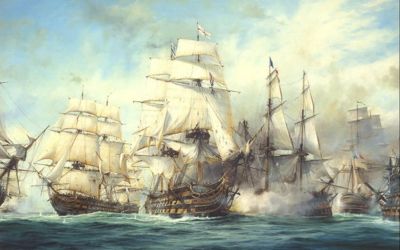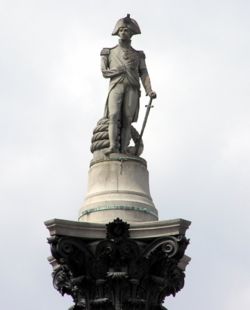Battle Of Trafalgar
 From Conservapedia
From Conservapedia 
The Battle of Trafalgar was a naval battle fought during the Napoleonic Wars on October 21, 1805 off the coast of southwestern Spain. It involved the Royal Navy under the command of Admiral Horatio Nelson, 1st Viscount Nelson against the combined forces of France and Spain. The destruction of the Franco-Spanish fleet gave Britain uncontested dominion over the world’s oceans for over 100 years, and it was because the British won the battle that they and not the French eventually came to rule an empire that included India, Canada, Hong Kong, and Singapore, and preside over a world economy in which London was the financial heart of Europe. The battle also immortalised the memory of Nelson who was shot by a French sharpshooter in the rigging of the enemy ships and died of his wounds at the moment of his greatest victory.
Contents
Background[edit]
In order to execute his plan to invade Britain in the summer of 1805, Napoleon Bonaparte needed to take control of the English Channel to allow his Grand Armée to safely cross. In preparation for this, he ordered the French fleet's three squadrons blockaded by the British at Brest, Toulon and other ports to break out and meet in the West Indies where they would regroup as a single fleet and return to take control of the Channel.
The French squadron commanded by Admiral Villeneuve at Toulon was able to break through the blockade in March 1805, and then joined up with a Spanish squadron, setting sail for the West Indies. Nelson received reports of the fleet heading for the West Indies on 10 April 1805 and took his fleet in pursuit, at which point Villeneuve decided that the odds were insurmountable and returned to Europe. A minor naval battle took place off Cape Finisterre on the west coast Spain, and Villeneuve was then forced to escape into the port at Cadiz in Spain. With the invasion now impossible, Napoleon turned his Grand Armée to attack Austria and Russia in the east.
Prelude to the battle[edit]
Nelson's fleet, consisting of 27 ships of the line, laid blockade at Cadiz, waiting for Villeneuve's force to attempt another break out. Following two years of blockading the French, the fleet was at its peak of fighting efficiency, and although the Franco-Spanish fleet had more technologically advanced vessels, including the largest warship in the world at that time, the 136-gun Spanish Santissima Trinidad, his crews were better disciplined and trained; also, British morale was high, as Nelson was already a much-renowned commander, and it was firmly believed by the British (and not without cause) that their navy and sailors was the best in the world.
Towards the end of September 1805, Nelson briefed his captains on the battle plan, which required his fleet to split into three columns to punch at right angles through the enemy line, then overwhelming the centre and rear sections of the enemy's fleet in what he called a "pell mell" battle (from the French pêle-mêle, meaning confused or messy). Captain Richard Keats, commanding officer of the 74-gun battleship HMS Superb, later related Nelson's plan: He said to me, "No day can be long enough to arrange a couple of Fleets and fight a decisive Battle according to the old system. I shall form the Fleet into three Divisions in three Lines. One Division shall be composed of twelve or fourteen of the fastest two-decked ships, which I shall keep always to windward, or in a situation of advantage and I shall put them under an officer who I am sure will employ them in the manner I wish if possible. I consider it will always be in my power to throw them into battle in any part I may choose. With the remaining part of the Fleet formed in two Lines I shall go at them at once, if I can about one third of their line from their leading ship." He then said, "What do you think of it?" Such a question I felt required consideration. I paused. Seeing it he said, "But I’ll tell you what I think of it. I think it will surprise and confound the enemy. They won’t know what I am about. It will bring forward a pell-mell battle and that is what I want."[1]
The Battle[edit]
On 19 October the British observed the Franco-Spanish fleet leaving Cadiz, under orders to try to break into the Mediterranean Sea. The main body of Nelson's fleet lay at anchor 48 miles off the coast and he immediately ordered pursuit. At dawn on 21 October the British fleet was only 9 miles away from the enemy, and at 11.48 am Nelson's flagship HMS Victory hoisted the signal England Expects That Every Man Will Do His Duty followed soon after by Engage the enemy more closely. Having insufficient vessels to form the originally intended three lines, two columns were formed, led by HMS Victory and Admiral Lord Collingwood's 100-gun ship of the line HMS Royal Sovereign. At this angle the British guns could not be brought to bear on the enemy, who opened fire with broadsides of their own uncontested. The wind had dropped and for the British fleet the approach was slower than planned, into a storm of cannon shot. Travelling at greater speed, Collingwood's ship breached the Franco-Spanish line well ahead of the rest of his column and the Royal Sovereign suffered heavily as she quickly drew the attentions of three French and three Spanish ships. As the columns cut through the enemy line they were able to "rake" their gunfire, firing into the bow and stern of enemy ships as they passed between them, this time the enemy guns unable to return fire.
The fighting that followed was severe and mostly at close quarters, the "pell mell" which Nelson had hoped for. Many of the British ships were seriously damaged, including Victory which had engaged the French flagship Bucentaure and the Redoutable. Nelson was relying on the superior gunnery and ship handling skills of the British, which eventually forced the surrender of Villeneuve 1.45pm, although some of the Spanish ships continued to mount fierce resistance until 4.30pm. Nelson himself was shot by a French musketeer around 1.15pm, and died from his wound at 4.30pm, having been informed that the battle was won. His body was preserved in a vat of brandy and taken back to England for a hero's funeral.

The total number of casualties on both sides totalled 8,500, and the British took 20,000 prisoners.
Commemoration of the battle[edit]
London's famous Trafalgar Square is named after the Battle of Trafalgar, and features a statue of Nelson on Nelson's Column, a 150-foot tall pillar in the center of the square. October 21 is celebrated in Britain each year as Trafalgar Day.
External links[edit]
- bbc.co.uk Animated Map: Battle of Trafalgar. Accessed 7 January 2008.
Further reading[edit]
- Adkin, Mark. The Trafalgar Companion: The Complete Guide to History's Most Famous Sea Battle and the Life of Admiral Lord Nelson (2005) excerpt and text search
- Adkins, Roy. Nelson's Trafalgar: The Battle That Changed the World (2006) excerpt and text search
- Corbett, Julian S. The campaign of Trafalgar (1919) full text online
References[edit]
- ↑ Sir Nicholas Harris Nicolas, The Dispatches and Letters of Lord Nelson (1844) London.
Categories: [Napoleonic Wars] [British History] [Spanish History] [French History] [Naval Battles]
↧ Download as ZWI file | Last modified: 02/11/2023 03:12:10 | 5 views
☰ Source: https://www.conservapedia.com/Battle_of_Trafalgar | License: CC BY-SA 3.0
 ZWI signed:
ZWI signed: KSF
KSF